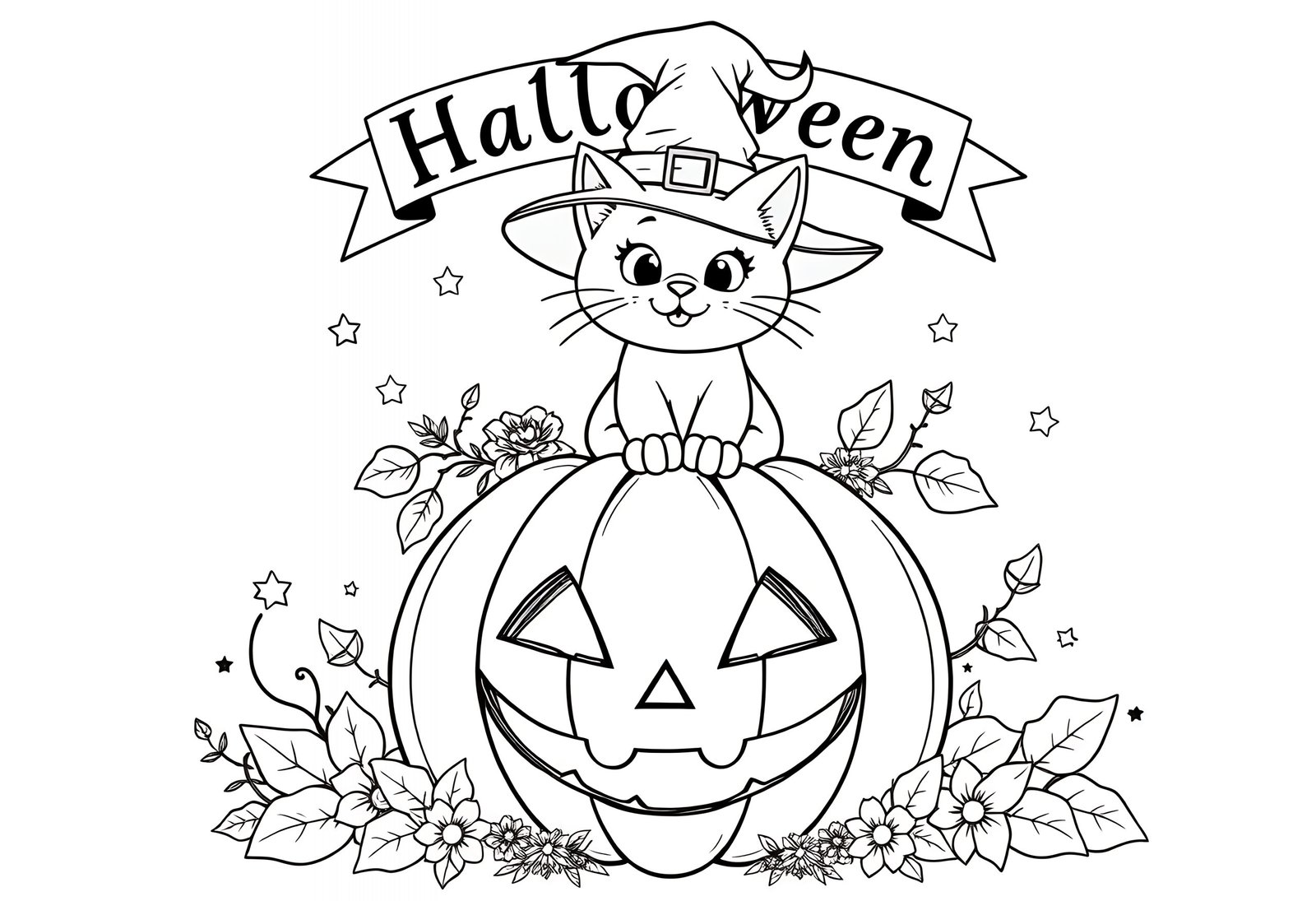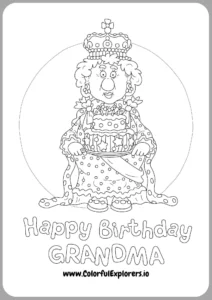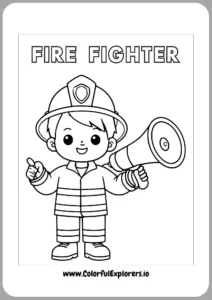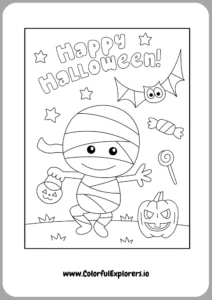Discover Halloween: Unveiling Origins and Traditions explores the rich history and traditions of the holiday, highlighting the blend of ancient practices and evolving customs. The holiday’s roots can be traced back to the Celtic festival of Samhain, which marked the end of summer and harvest, and the Roman influence on the holiday. The evolution of Halloween in America began with limited acceptance in colonial New England, but with the arrival of Irish and Scottish immigrants, it gained more acceptance. The 20th century saw a shift towards organized, family-friendly activities, with trick-or-treating becoming a popular tradition. The art of costume and trick-or-treating has deep European and Celtic roots, with costumes often meant to conceal one’s identity to avoid recognition by spirits. Colorful Explorers can use coloring pages to explore different historical costume styles and learn more about the holiday’s origins and traditions.
Halloween is a time of symbols, games, and entertainment, with pumpkins being a popular medium for carving Jack-o’-lanterns. The tradition spread to America, with pumpkins representing the harvest and the transition of the season. Other symbols include black cats, ghosts, and colors like black, orange, and purple. Halloween entertainment includes Halloween parties, horror films, and haunted attractions. The “Halloween” franchise, along with “Scream” and “Nightmare on Elm Street,” has become a classic. The Halloween experience also includes the haunted attraction industry, with events like Six Flags Fright Fest and Universal Studios Florida’s Halloween Horror Nights being major draws. The American economy sees a massive surge during Halloween, with an estimated $12.2 billion spent in 2023. Coloring Pages can help explore these diverse cultural expressions and provide educational tips and crafting ideas.
Table of Contents
ToggleDiscover Halloween: Unveiling Origins and Traditions
Welcome, Colorful Explorers! As someone deeply fascinated by the vibrant tapestry of global celebrations, I find Halloween to be a truly captivating subject. It’s a holiday that conjures images of spooky fun, but its origins are far richer and more complex than many realize. This exploration will unveil the history and traditions of Halloween, demonstrating how a blend of ancient practices and evolving customs shaped the celebration we know today.
The Deep Roots of Allhallowtide and Samhain
Our journey begins with Allhallowtide, a Christian observance encompassing All Saints’ Eve, All Hallows’ Day, and All Souls’ Day. The very term “Halloween” itself is a contraction of “All Hallows’ E’en,” or “All Hallows’ Evening,” stemming from Old English. This Scots word reflects a historical connection to Christianity, where the evening before All Hallows’ Day became a significant period.
However, the story predates organized Christianity as we know it. The ancient Celtic festival of Samhain (pronounced “sow-in”), observed around October 31 to November 1, is the foundational element. As someone who’s delved into various ancient calendars, the concept of quarter days marking significant seasonal shifts is quite common. For the Celts, primarily located in Ireland, Scotland, and the Isle of Man, Samhain marked the end of summer and harvest, ushering in the “dark half” of the year. This period was intrinsically linked to the Otherworld and the Aos Sí, spirits or fairies who were believed to cross into the human realm. To appease these entities, offerings of crops, food, and drink were left out. Candles were lit, and prayers were offered for the dead. Large bonfires were central to these celebrations, serving both as protective measures against malevolent spirits and for divination rituals.
The Roman influence also played a part. After the Roman Empire conquered Celtic lands, two Roman festivals, Feralia (commemorating the passing of the dead) and a day to honor Pomona (goddess of fruit and trees), merged with Samhain. The symbol of Pomona is the apple, and this convergence explains the enduring tradition of bobbing for apples on Halloween.
Speaking of ancient practices, for those who enjoy our Ancient Civilizations: Coloring Pages, you might find it fascinating to draw parallels between the symbolic elements of Halloween and the ways ancient cultures depicted the transition between life and death.
The Evolution of Halloween in America
The initial presence of Halloween in North America was quite limited, particularly in colonial New England, due to the rigid beliefs of the Puritans. However, in areas like Maryland, with its Catholic colonists, the holiday found more acceptance. The significant Irish immigration and Scottish immigration in the 19th century dramatically changed the landscape of Halloween in America. These new arrivals brought their vibrant traditions with them, helping to popularize the celebration nationally.
Over time, as different European ethnic groups and American Indians interacted, a distinctively American Halloween emerged. Early celebrations often involved “play parties,” communal events to celebrate the harvest where neighbors shared stories of the dead, told fortunes, danced, and sang. These festivities also included ghost stories and various forms of mischief-making. By the mid-19th century, autumn festivities were common, though Halloween wasn’t universally celebrated.
The 20th century saw Halloween transform even further. What was once largely a community-centered holiday, with parades and town-wide Halloween parties, began to see an increase in vandalism. As a response, community leaders and schools encouraged a shift towards more organized, family-friendly activities. This led to parties moving from civic centers to classrooms and homes, especially with the baby boom of the 1950s bringing a high number of young children.
This era also saw the widespread revival of trick-or-treating. This practice, with roots in souling and mumming traditions, became an inexpensive way for communities to share the celebration. The idea was that by providing treats, families could prevent tricks. And thus, a new American tradition was born, one that has only continued to grow.
For our Historical Landmarks: Coloring Pages, imagine designing a page featuring a late 19th-century American street scene with early trick-or-treaters!
The Art of Costume and Trick-or-Treating
The act of dressing up for Halloween, or guising as it’s known in some traditions, has deep European and Celtic roots. Historically, costumes were often meant to conceal one’s identity to avoid recognition by spirits believed to roam the earth on Samhain night. Early 20th-century Halloween costumes were largely homemade and leaned heavily into spooky themes like witches, ghosts, and skeletons.
The 1890s saw “false faces” appearing in places like Ayr, Scotland. Over time, mass-produced box costumes became more affordable, especially in the 1950s, allowing more children to participate in elaborate dress-up. Costumes also began to draw inspiration from current events and popular culture, like the launch of Sputnik in 1957. As store-bought costumes became accessible, parents could easily suit up their children for the holiday, sometimes at the last minute! The 1960s brought more elaborate masks, and by the 1970s, movies significantly influenced costume choices, giving us iconic looks like Star Wars characters and the infamous Richard Nixon mask after the 1978 film.
Regarding trick-or-treating, its history is quite fascinating. Borrowing from European traditions, Americans began to go door-to-door asking for food or money. Early mentions of the specific “trick or treat” term can be traced to newspapers like the Blackie Herald in 1934. Over time, the practice evolved, with community leaders encouraging it as a way to curb mischief. Modern iterations include tailgating and trunk-or-treat events, often held in church parking lots, where vehicles are decorated and candy is distributed from the trunk or boot for enhanced safety and convenience, especially for families in rural homes or those wanting to avoid walking half-mile distances.
For a fun crafting idea that connects to this, children can design their own masks using our Costume Party Fun: Coloring Pages and explore different historical costume styles.
Symbols, Games, and Halloween Entertainment
Halloween is rich with symbols. Jack-o’-lanterns, originally carved from turnips in Irish folklore to ward off evil spirits, found a new medium in pumpkins when the tradition spread to America. The pumpkins themselves, along with autumn elements like corn husks and scarecrows, symbolize the harvest and the transition of the season. Other pervasive symbols include black cats (linked to medieval beliefs about witches), ghosts, and colors like black, orange, and purple. The idea of death and evil is often present, drawing from older associations.
Halloween is also a time for traditional games and activities. Apple bobbing, or “dunking,” as it’s called in Scotland, remains popular, where participants try to retrieve apples from a tub or basin of water using only their teeth. Many variations exist, including trying to get an apple from a chair with a fork or picking up a coin from the bottom of a basin with your teeth. Other historical rituals involved hazelnuts for divination and even scrying with mirror-gazing. There were also less-known rituals focused on matchmaking, like young women trying to divine the name of their future husband by tossing apple peels over their shoulders or observing egg whites floating in water.
Modern Halloween entertainment includes Halloween parties and, famously, horror films. The “Halloween” franchise, starting with the 1978 original film directed by John Carpenter, became a classic. These films, alongside others like “Scream” and “Nightmare on Elm Street,” cemented the “slasher film” genre as a fixture of the holiday. More family-friendly options include “Hocus Pocus” and “It’s the Great Pumpkin, Charlie Brown.”
A significant aspect of the modern Halloween experience is the haunted attraction industry. From carnival funhouses to massive theme park haunts, these venues provide immersive experiences for patrons. Early examples include the Orton and Spooner Ghost House in Liphook, England, from the 1930s. In America, haunted houses became popular in the late 1950s, with institutions like the San Mateo Haunted House and Disneyland’s Haunted Mansion. Today, events like Six Flags Fright Fest and Universal Studios Florida’s Halloween Horror Nights are major draws.
To bring this section to life, our Spooky Scenery: Coloring Pages offers fantastic opportunities to color haunted houses and other classic Halloween backdrops.
Halloween and Global Traditions
While Halloween has a strong presence in North America, particularly the United States and Canada, its influence has spread. Countries in the Far East, mainland Europe, and even parts of South America like Brazil, Colombia, Ecuador, and Chile, and Oceania like Australia and New Zealand have seen an Eastern adoption of some traditions.
For example, in Mexico, the Día de los Muertos (Day of the Dead) is a related but distinct celebration that honors deceased loved ones with altars and offerings. Although separate, some Halloween elements have blended with local festivities in various regions.
For Christian observances, All Hallows’ Eve is a vigil of All Hallows. In the Episcopal Christian church, for instance, prayers, fasting, and church service are common. Some churches offer “Light Parties” or “Hallelujah Nights” as an alternative, focusing on Jesus as the “Light of the World.” In Finland, cemeteries are illuminated with votive candles, creating “seas of light” (valomeri).
Different religious groups approach Halloween in varied ways. While Jews historically avoid Gentile customs, some find parallels to holidays like Purim, where costumes are worn. Muslims generally consider Halloween to be haram (forbidden) due to its association with “the spirit of death.” Hindus have their own rich festival traditions, like Pitru Paksha for honoring ancestors and Diwali, the festival of lights, which bears no relation to Halloween. For Neopaganism and Wiccans, Samhain is a significant spiritual holiday, often celebrated with Halloween festivities.
Did you know that in terms of cost, the American economy sees a massive surge during Halloween? The National Retail Federation reported that Americans spent an estimated $12.2 billion on Halloween in 2023, up from $10.6 billion in 2022. A significant portion of this, $3.9 billion, goes towards home decorations, and $2.7 billion goes towards Halloween decorations in general. This makes Halloween the country’s second-largest commercial holiday after Christmas.
For those interested in exploring these diverse cultural expressions, our Global Festivals: Coloring Pages would be an excellent resource for learning about different celebrations worldwide.
Educational Tidbits and Crafting Ideas
Let’s delve into some fun facts and crafting ideas:
- Bats on Halloween: Bats are often associated with Halloween, largely due to their nocturnal nature and historical links to darkness and mystery. There are over 1,400 species of bats worldwide! Some common types you might imagine for Halloween imagery include
- Common Vampire Bat: Found in Central and South America, known for feeding on the blood of mammals and birds.
- Little Brown Bat: A widespread species in North America, often found in caves and attics.
- Fruit Bat: Larger bats that primarily eat fruit, common in tropical regions.
- Mexican Free-tailed Bat: Known for forming massive colonies, like the famous ones in Austin, Texas.
- Crafting Idea: DIY “Soul Cakes”: While you might not “go a-souling” today, you can make your own version of “soul cakes”! These are small, spiced cakes traditionally given to the poor on All Souls’ Day. Using our Sweet Treats: Coloring Pages as inspiration, design your own “soul cake” wrappers or decorations.
- Pumpkin Carving Evolution: Did you know that the turnip was the original vegetable used for carving in Ireland and Scotland? When immigrants came to America, they found pumpkins to be much easier to carve, leading to the Jack-o’-lantern we know today. You can compare the differences in our Pumpkin Patch Fun: Coloring Pages and Garden Delights: Coloring Pages.
- Apple Bobbing Variants: Beyond just grabbing apples with your teeth, historical apple bobbing games included trying to retrieve a coin from the water using only your mouth or attempting to grab an apple that had a lit candle on a wooden rod at head height with your teeth.





